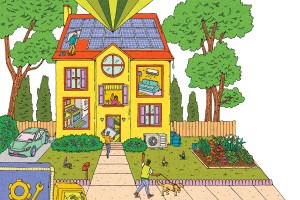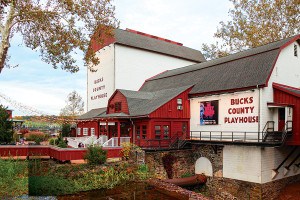A Look at Villanova’s New Lancaster Avenue Building

Villanova’s new mixed-use development will enliven the corner of Lancaster Avenue (foreground) and Ithan Avenue. | Rendering © Robert A.M. Stern Architects, courtesy Brian Communications
With its announcement that it will build a new, 1,100-bed student residence hall with street-floor retail across Lancaster Avenue from the main entrance to its campus, Villanova University has taken a small but significant step towards making its campus look and feel more like a community.
That’s because the mixed-use building, designed by Robert A.M. Stern Architects in partnership with Voith & McTavish Architects and to be built by Torcon, will replace what is now a large surface parking lot at the corner of Lancaster and South Ithan avenues.
It will also make Villanova students themselves more a part of a community, according to Chris Kovolski, assistant vice president for government relations and external affairs at Villanova.
As he described the current state of affairs, many Villanova students who would like to live on campus can’t. “Adding additional student housing is something the university has been investigating for some time,” he said. “A number of factors make this the right time to build. We have more students living in the community than we’d like to have, and there are more students who would like to live on campus than we can house.”
This building is intended to fill that demand and to keep up with the pace and type of amenities colleges in Villanova’s class are providing. In addition to dormitory suites, the building will contain a state-of-the-art fitness center, a mailing facility, a bistro and convenience store and a Villanova apparel store.
Kovolski explained that the commercial component was intended to complement rather than compete with nearby local merchants. “There are lots of local places our students patronize, and we don’t want to compete with them,” he said. “But these are spaces our students and their parents want, so we have a small commercial component in this project.”
The building is also designed to be environmentally sensitive. “New community green spaces, innovative storm water controls and many green aspects will be incorporated into the new construction,” said Mike Armento, senior vice president at Torcon. Among those features are a rainwater harvesting system that will feed the campus’ cooling towers, a sunlight harvesting system that adjust shades and lighting to make maximum use of sunlight entering the rooms, and a commitment to using as much recycled material and building materials produced within 500 miles of the construction site as possible. Needless to say, the project will seek LEED certification.
A community park to be located across the Norristown High-Speed Line tracks from the building site is also part of the project. “The park will be enhanced by adding trees and plants in compliance with Radnor Township’s Shade Tree Commission while continuing Villanova’s dedication to fostering a welcoming environment for the local community,” Armento said.
One goal of the project is to reduce the need for students to drive to campus, according to Kovolski. “We’re able to house 4,400 of our 6,400 students now,” he said. “That’s a lot of driving back and forth. By adding 1,150 beds, we turn those students into residents.” However, that leaves almost 1,000 students living off campus, and the main lot the building will replace is also used by faculty and staff. So the development will replace just about all of the parking to be eliminated by building on that lot. Most of the 1,300 parking spaces will be contained in a new garage to be built across Ithan Avenue from this building, but some of the spaces will end up in smaller lots along Lancaster Avenue to the west of the building site after neighbors expressed concern about the garage’s height and size. The parking, however, will be for the exclusive use of members of the Villanova community. Besides, a future phase of construction will see a performing arts center rise on the smaller lot at the southeast corner of Lancaster and Ithan avenues.
Between this dorm and the future performing arts center, Villanova is taking a major step towards creating something it hasn’t had before: a college-town vibe at its own doorstep. Of the region’s three major Catholic universities, only St. Joseph’s has a commercial district that serves the campus at its doorstep, and this will give Villanova the start of one, enlivening this stretch of Lancaster Avenue in the process. (The third, La Salle, chose instead to develop retail space that serves its neighbors more than its students by building a supermarket and shopping center on the site of its former football stadium in Germantown.)
But it will only be the start of one, and given how the rest of the land Villanova owns in the vicinity will be developed, it really won’t grow beyond that. This will be good news for the local pizzeria and cafe as well as the businesses in nearby Bryn Mawr and Wayne, the two shopping, dining and entertainment hubs closest to campus, but it may mean that students will still do some driving back and forth to get to those hubs. Perhaps the university might want to invest in transit passes for residents of the new dorm and point them to Villanova station on the NHSL, which has a stop in Bryn Mawr. Besides, with a pedestrian bridge spanning Lancaster as part of this project, it will be easier for students to travel between the train station and the heart of campus. (It will also make it easier for parishoners at St. Thomas of Villanova Church, located at the main entrance, to get from the train to Mass.)
“We think this will create a great streetscape, and not a monolithic one,” said Kovolski. The neo-Academic Gothic building will certainly complement the architecture of campus. We can hope that the rest of the project works as Villanova hopes it will.
[Updated June 1, 11:12 a.m., to correct the spelling of Kovolski’s name.]


